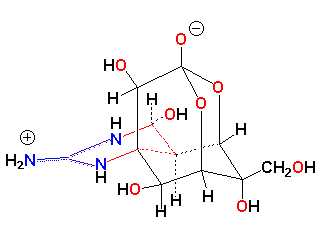Tuesday, January 18, 2011
January 18, 2011 : Tetrodotoxin
Tetrodotoxin
Tetrodotoxin (also known as "tetrodox" and frequently abbreviated as TTX, sometimes colloquially referred to as "zombie powder" by those who practice Vodou or are of Haitian descent) is a potent neurotoxin with no known antidote. There have been successful tests of a possible antidote in mice, but further tests must be carried out to determine efficacy in humans. Tetrodotoxin blocks action potentials in nerves by binding to the voltage-gated, fast sodium channels in nerve cell membranes, essentially preventing any affected nerve cells from firing by blocking the channels used in the process. The binding site of this toxin is located at the pore opening of the voltage-gated Na+ channel. Its name derives from Tetraodontiformes, the name of the order that includes the pufferfish, porcupinefish, ocean sunfish or mola, and triggerfish, several species of which carry the toxin. Although tetrodotoxin was discovered in these fish and found in several other animals (e.g., blue-ringed octopus, rough-skinned newt, and Naticidae) it is actually produced by certain symbiotic bacteria, such as Pseudoalteromonas tetraodonis, certain species of Pseudomonas and Vibrio, as well as some others that reside within these animals.
Tetrodotoxin has been isolated from widely differing animal species, including western newts of the genus Taricha (where it was termed "tarichatoxin"), pufferfish, toads of the genus Atelopus, several species of blue-ringed octopodes of the genus Hapalochlaena (where it was called "maculotoxin"), several sea stars, certain angelfish, a polyclad flatworm, several species of Chaetognatha (arrow worms), several nemerteans (ribbonworms) and several species of xanthid crabs. The toxin is variously used as a defensive biotoxin to ward off predation, or as both a defensive and predatory venom (the octopodes, chaetognaths and ribbonworms). Tarichatoxin and maculotoxin were shown to be identical to tetrodotoxin in 1964 and 1978, respectively. Recent evidence has shown the toxin to be produced by bacteria within blue-ringed octopuses. The most common source of bacteria associated with TTX production is Vibrio bacteria, with Vibrio alginolyticus being the most common species. Pufferfish, chaetognaths, and nemerteans have been shown to contain Vibrio alginolyticus and TTX.
Tetrodotoxin is roughly 100 times more poisonous than potassium cyanide. Fish poisoning by consumption of members of the order Tetraodontiformes is extremely serious. The organs (e.g. liver) of the pufferfish can contain levels of tetrodotoxin sufficient to produce paralysis of the diaphragm and death due to respiratory failure. Toxicity varies between species and at different seasons and geographic localities, and the flesh of many pufferfish may not usually be dangerously toxic. It is not always entirely fatal; however, at near-lethal doses, it can leave a person in a state of near-death for several days, while the person continues to be conscious.
Subscribe to:
Post Comments (Atom)


No comments:
Post a Comment